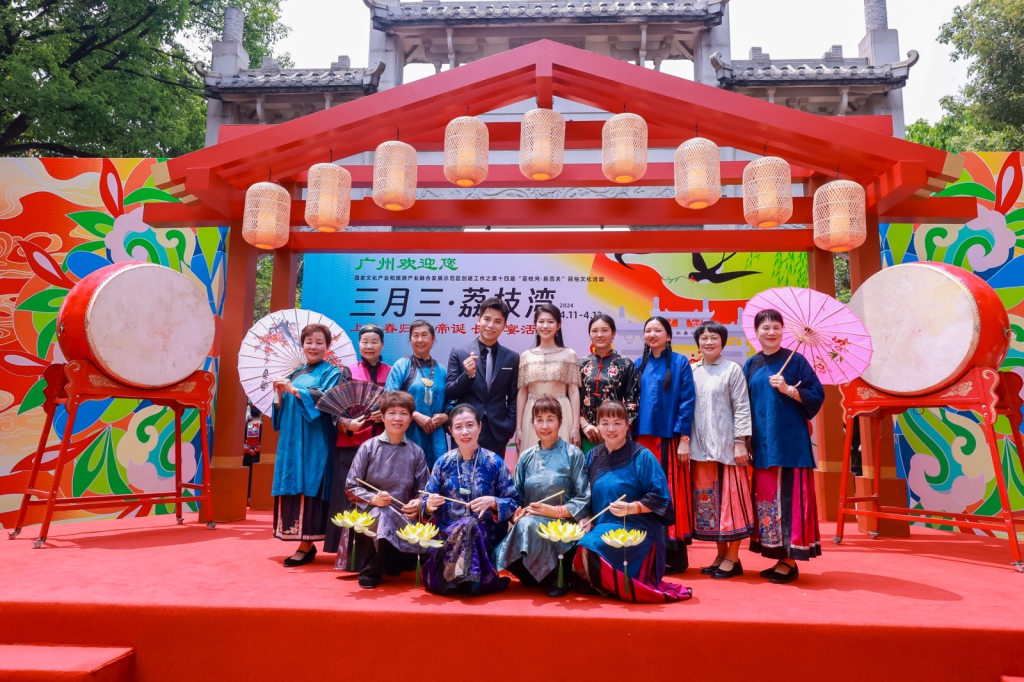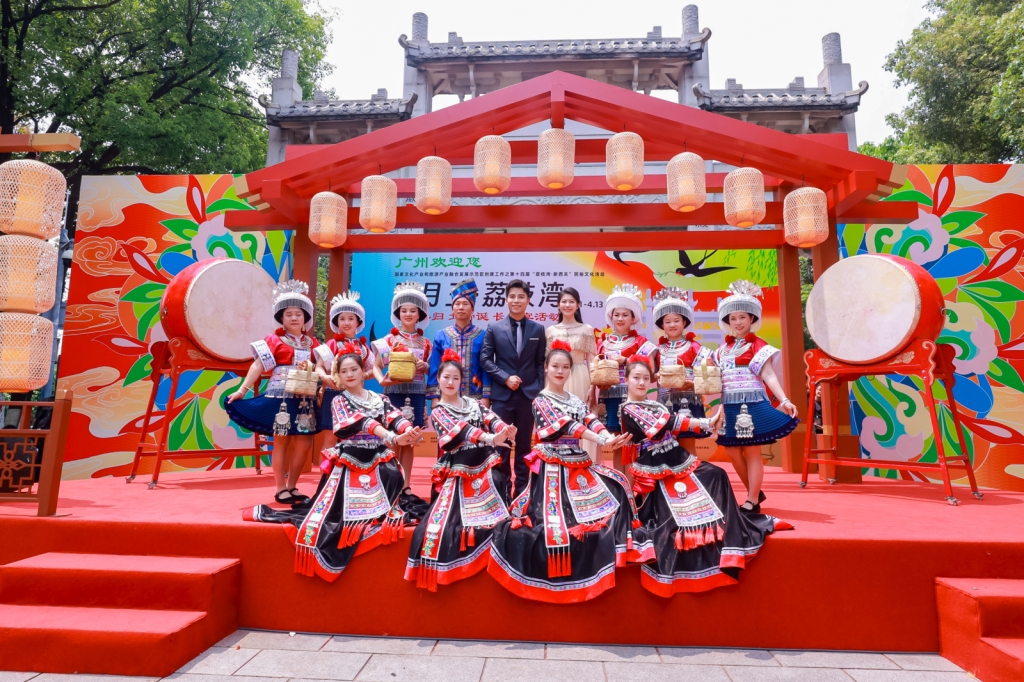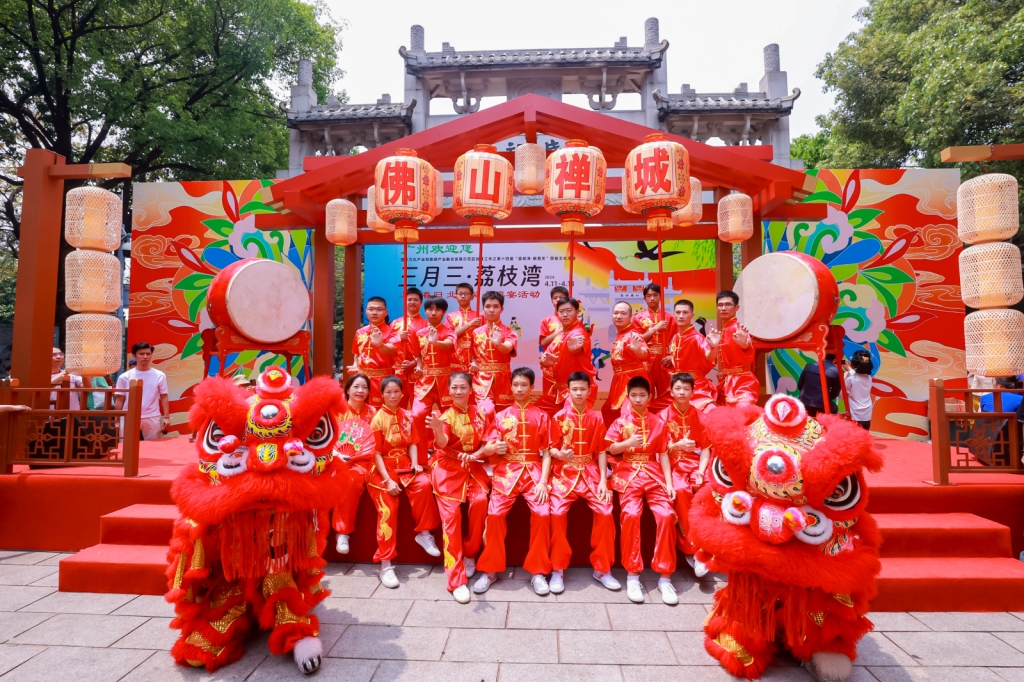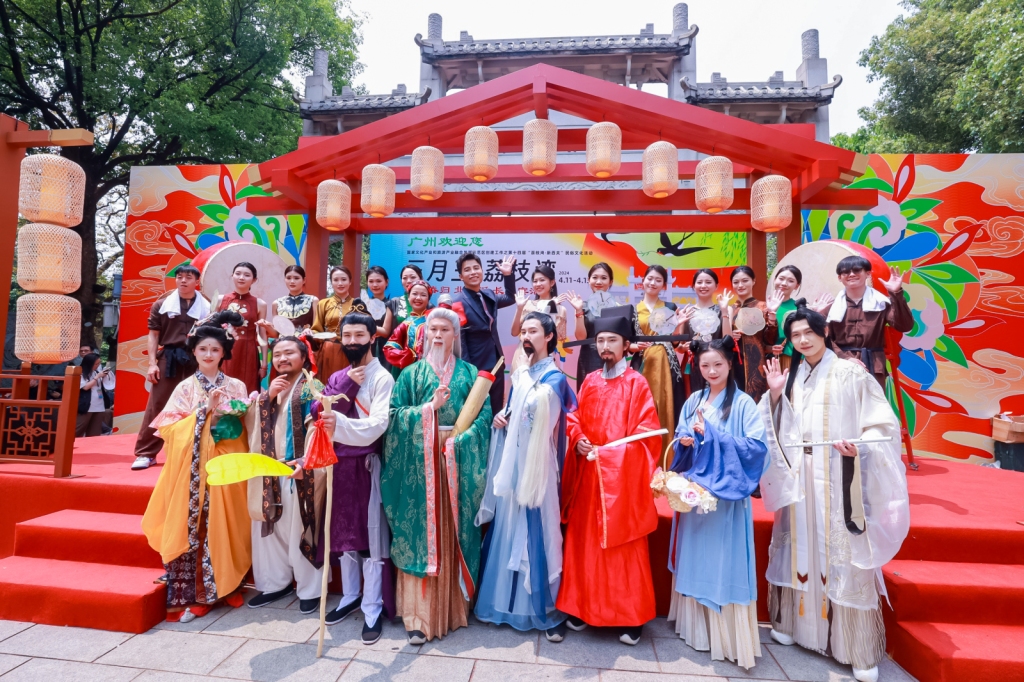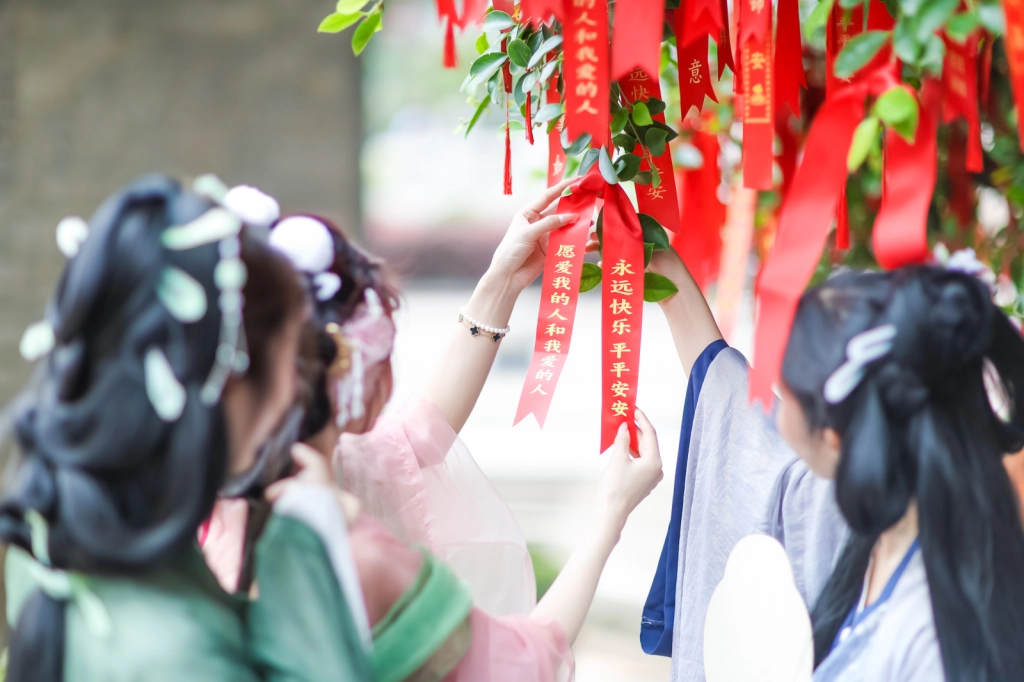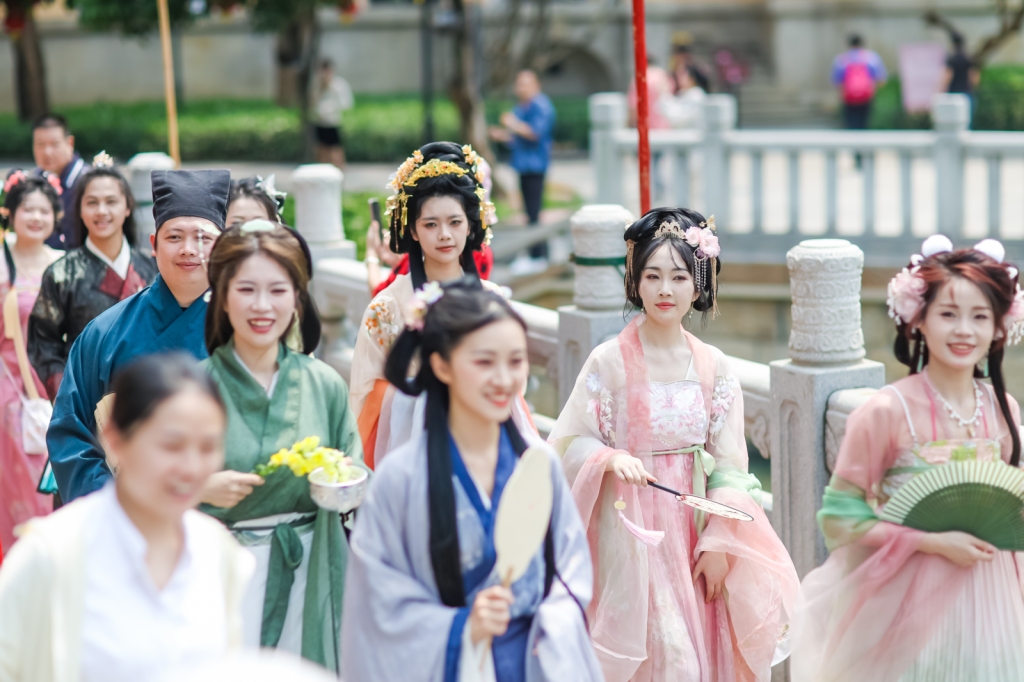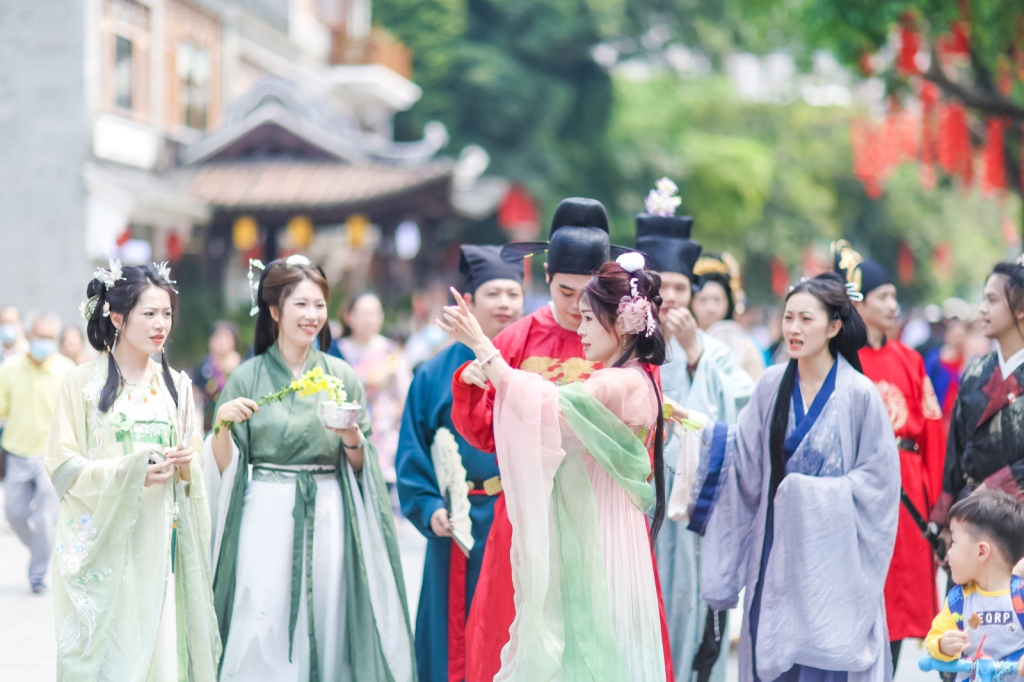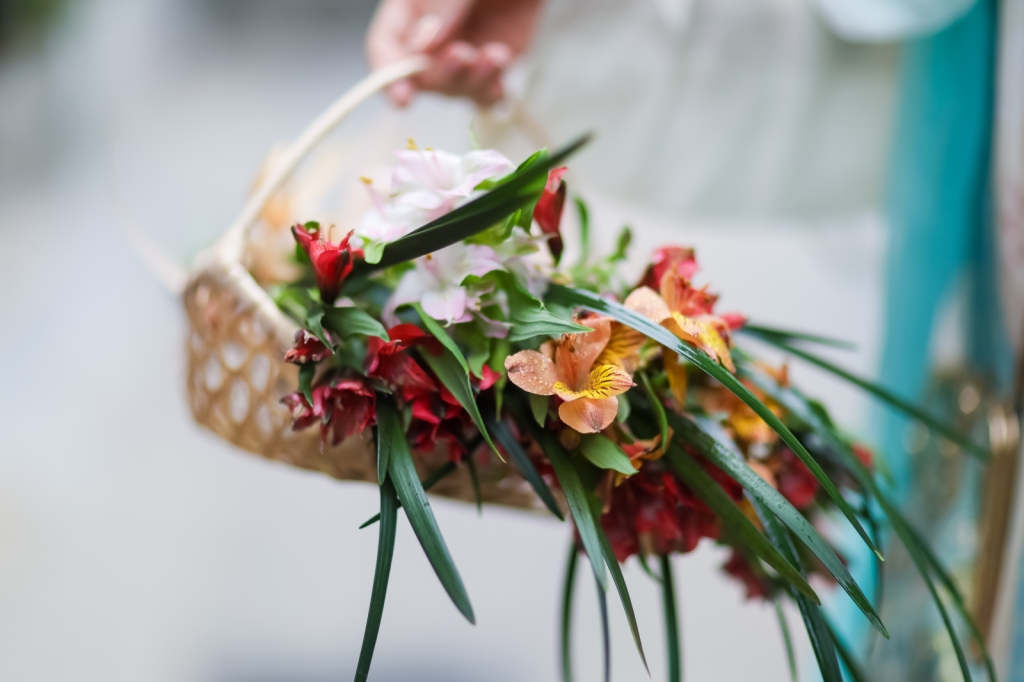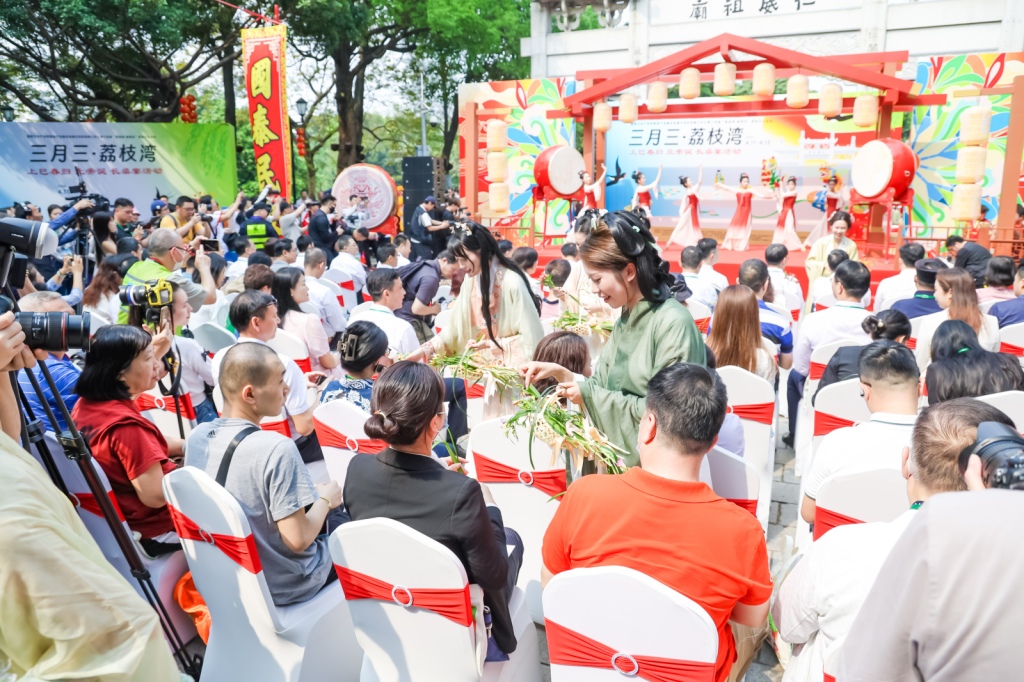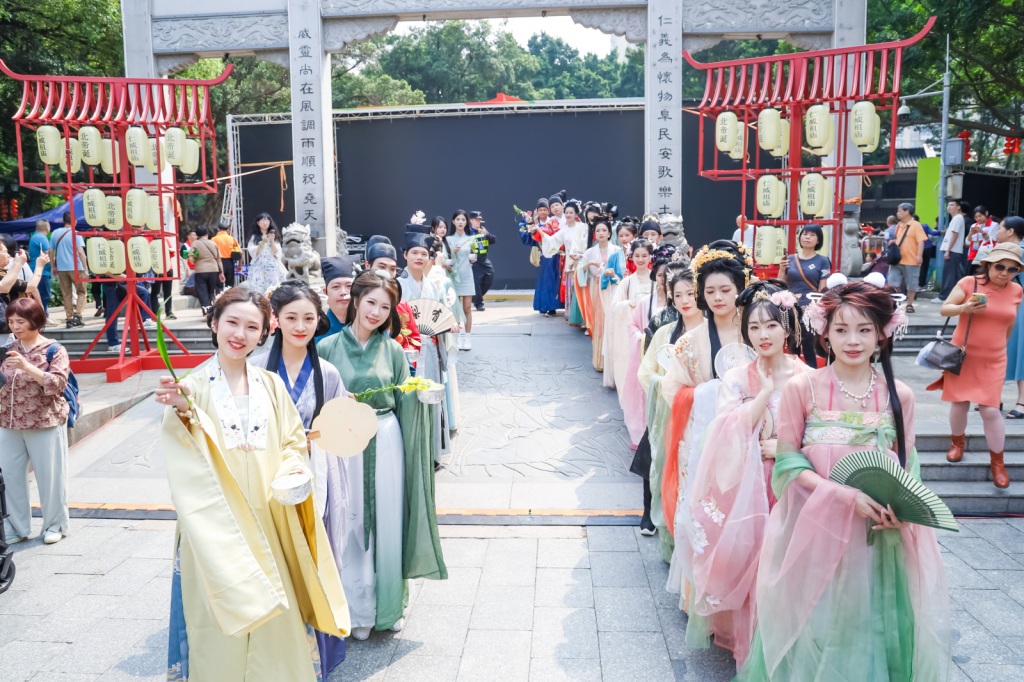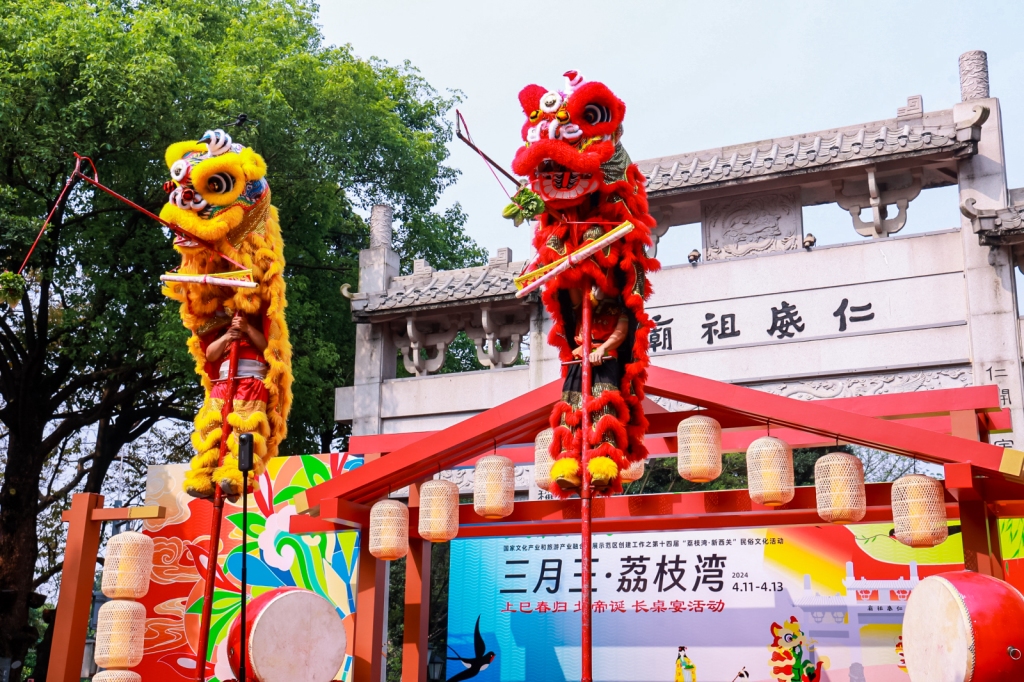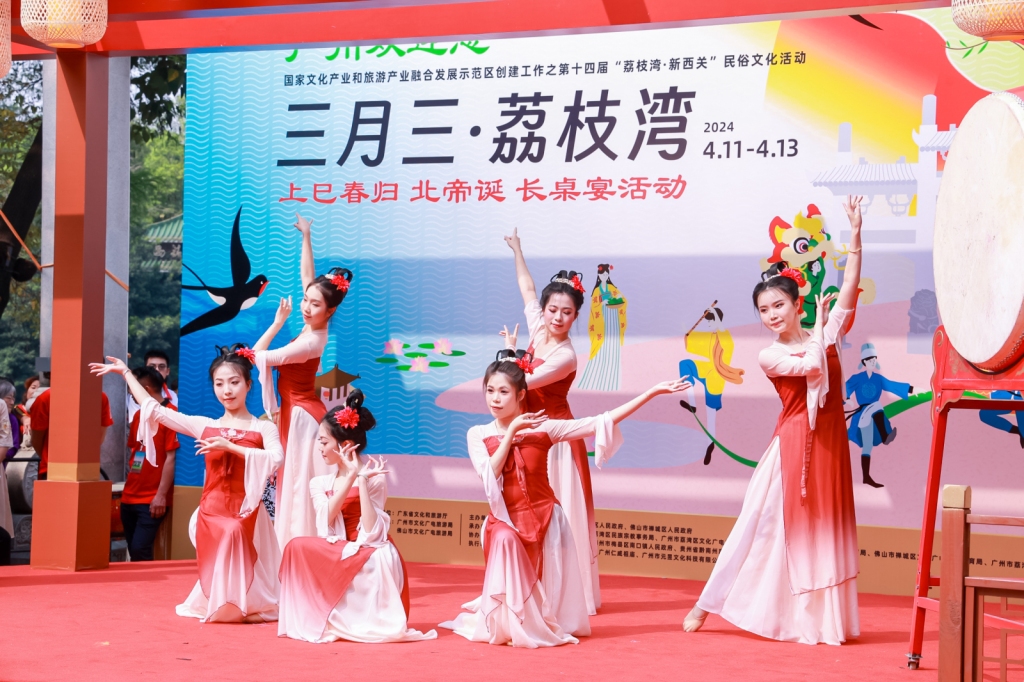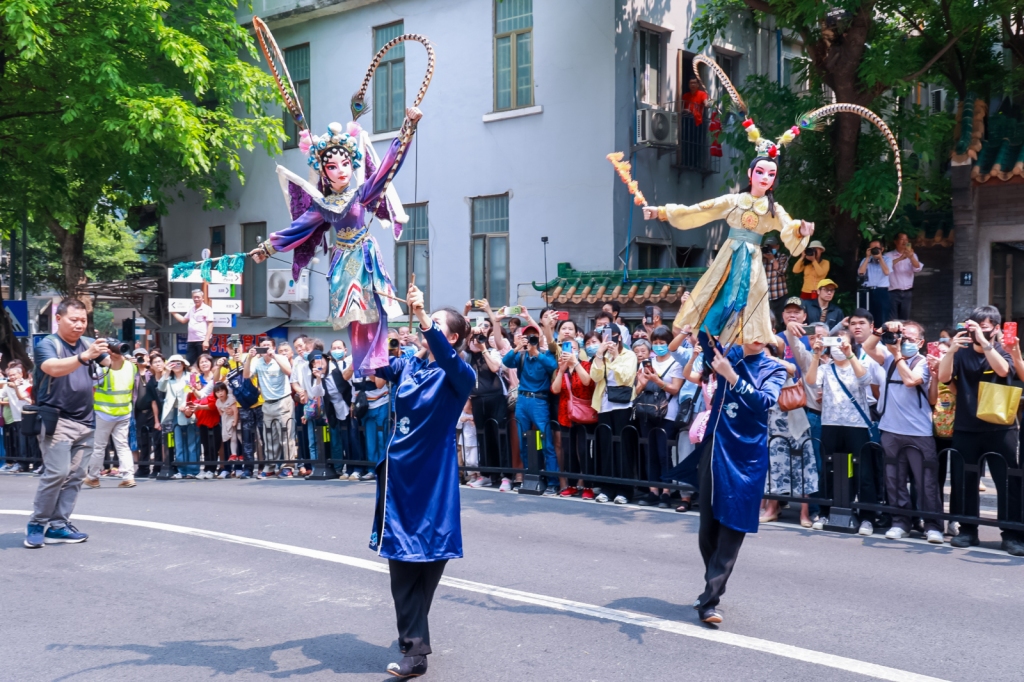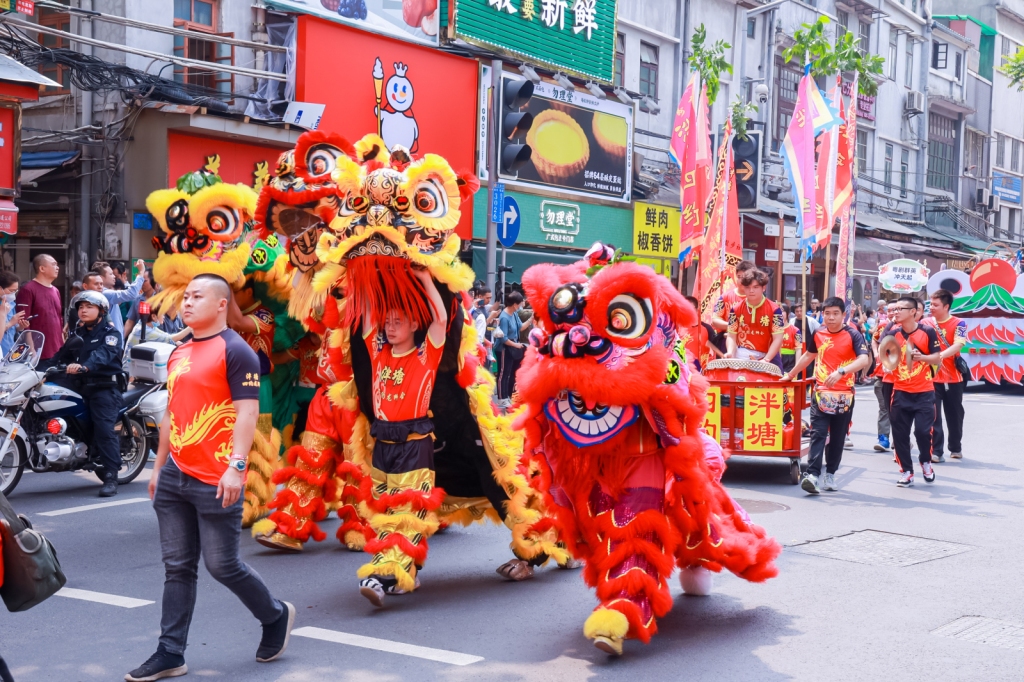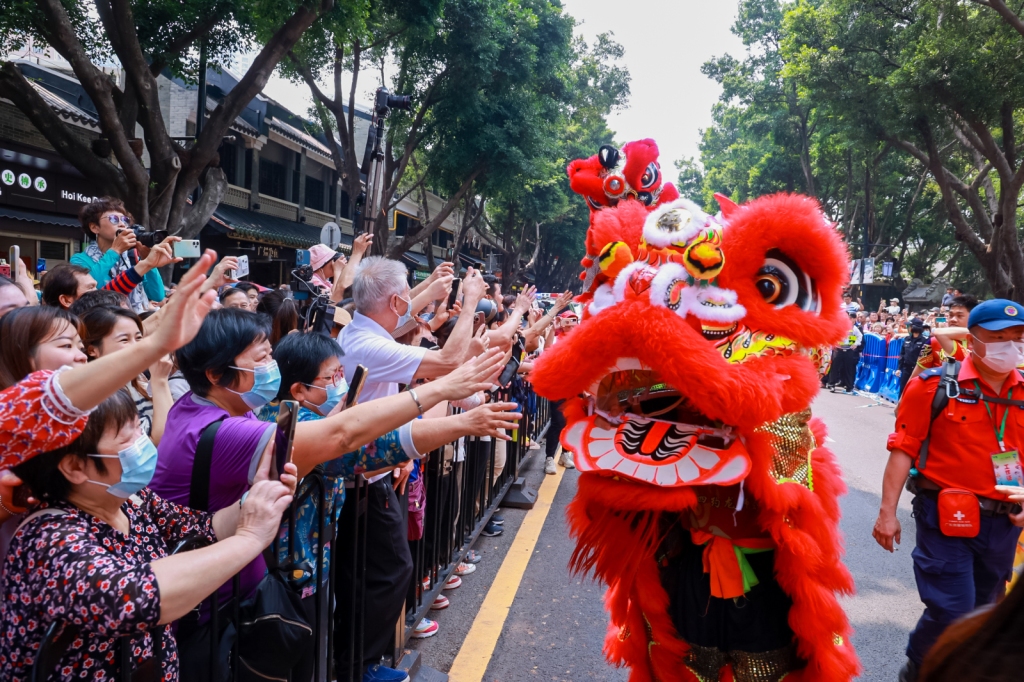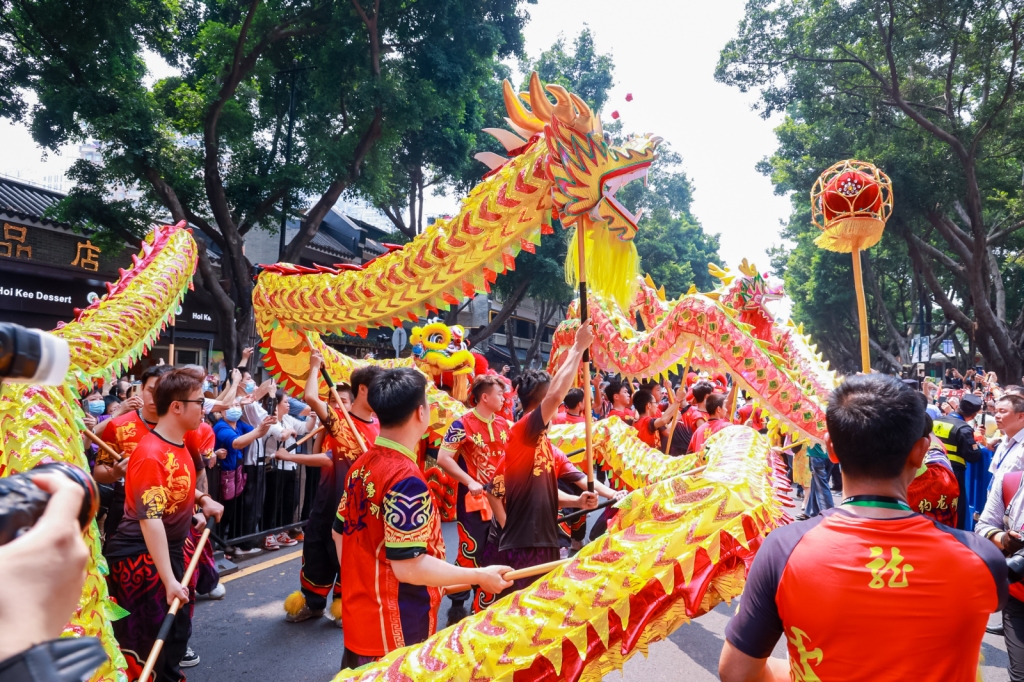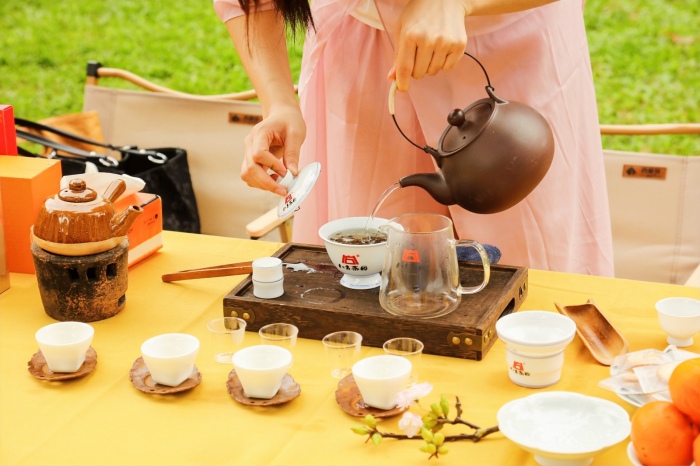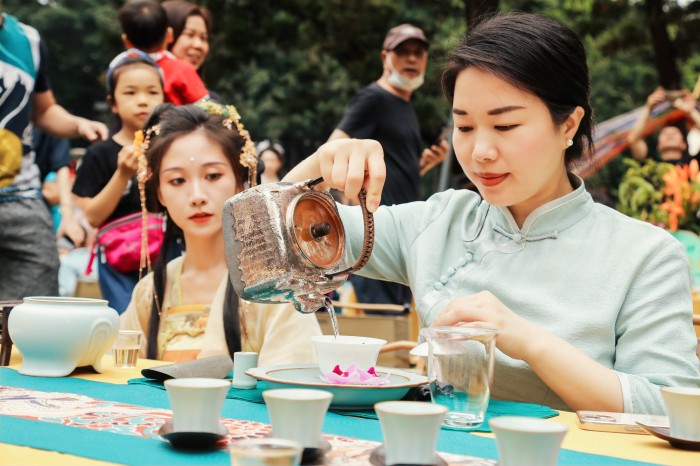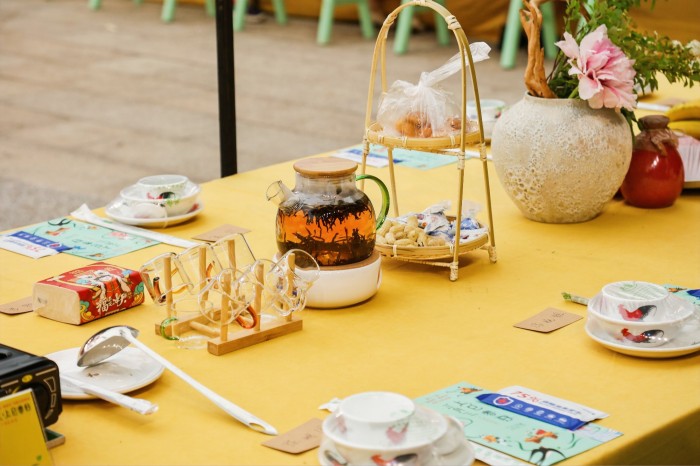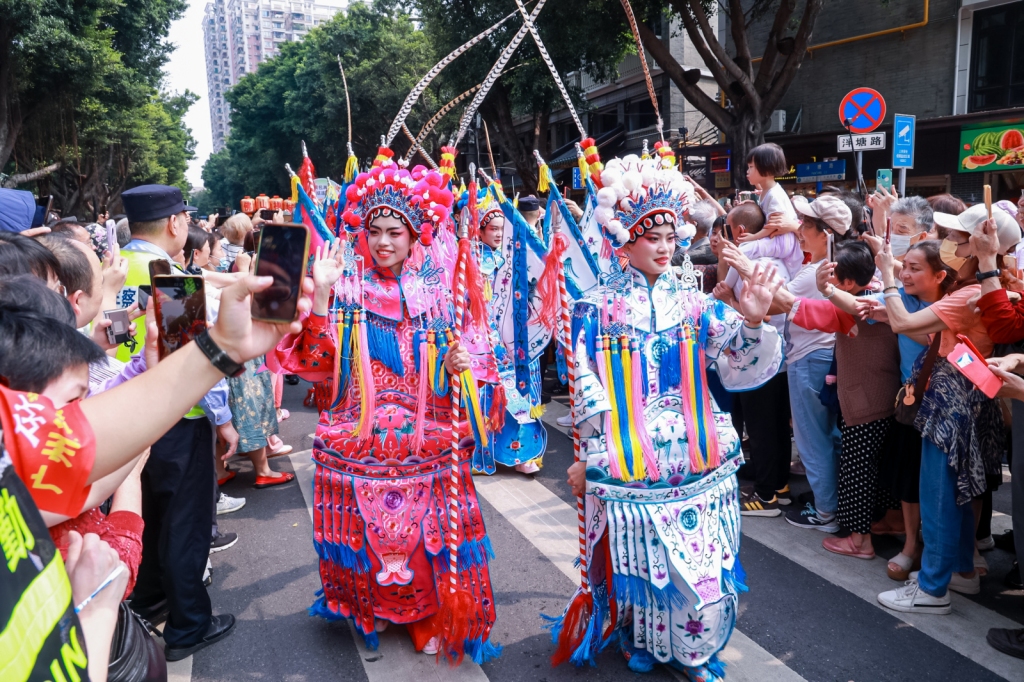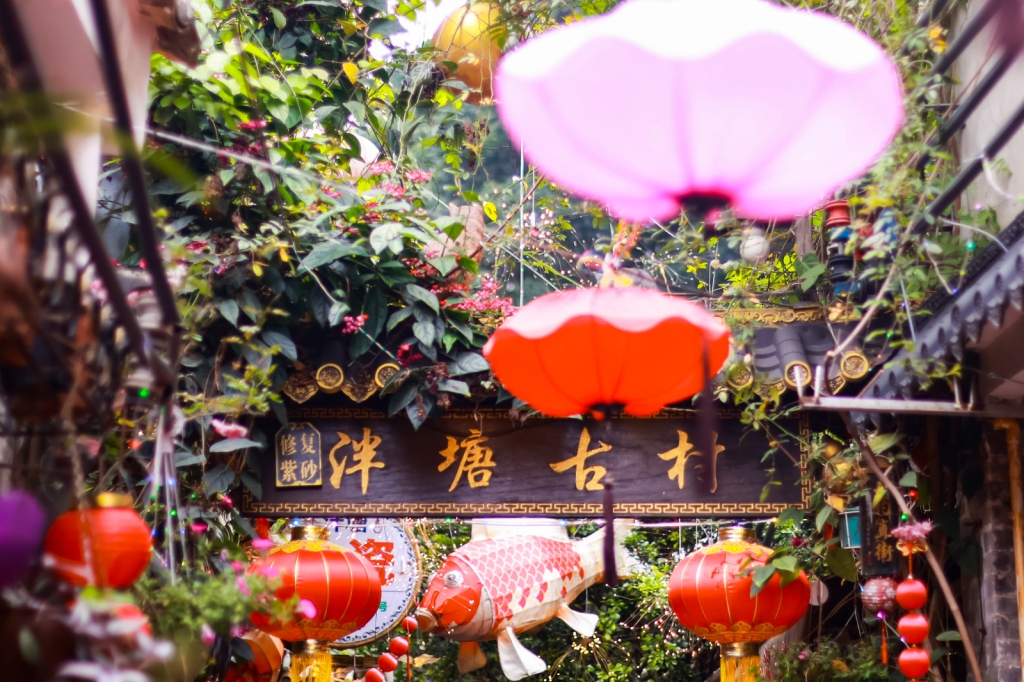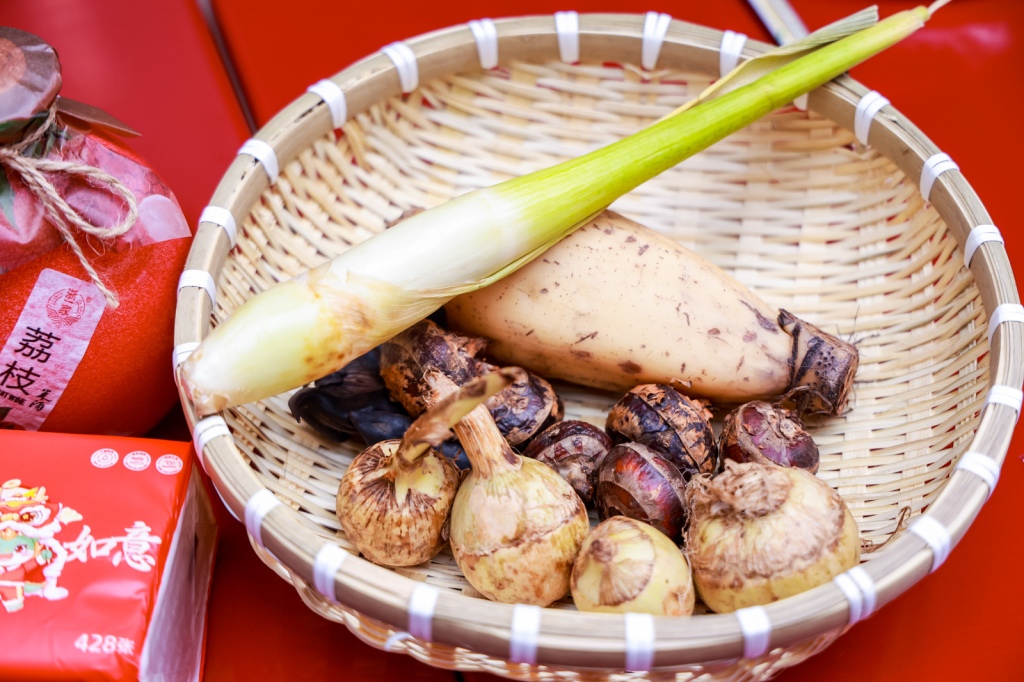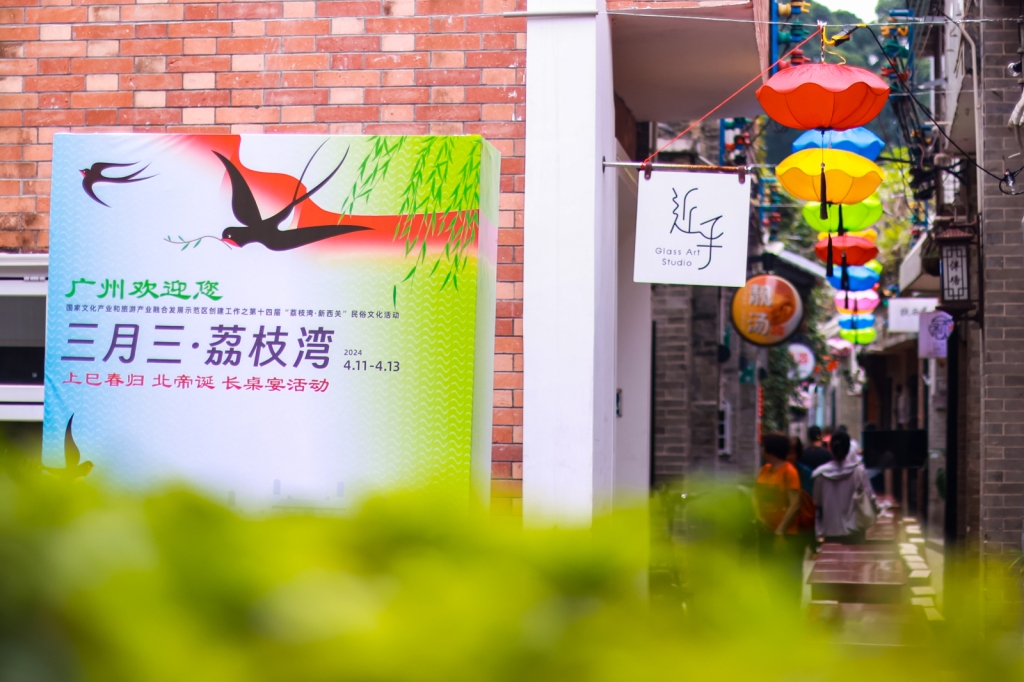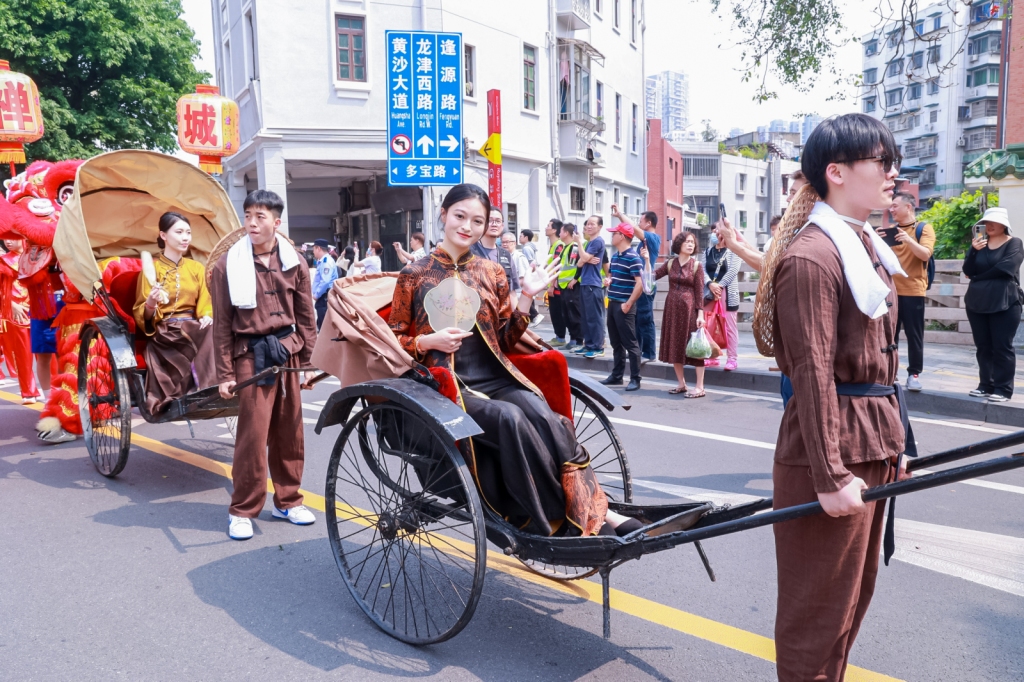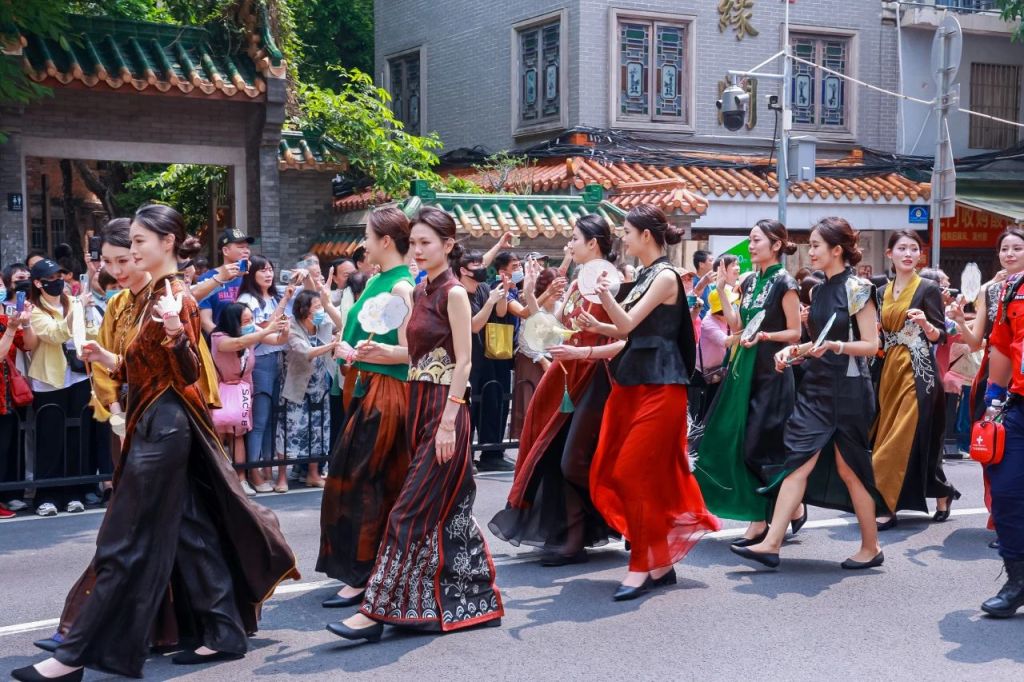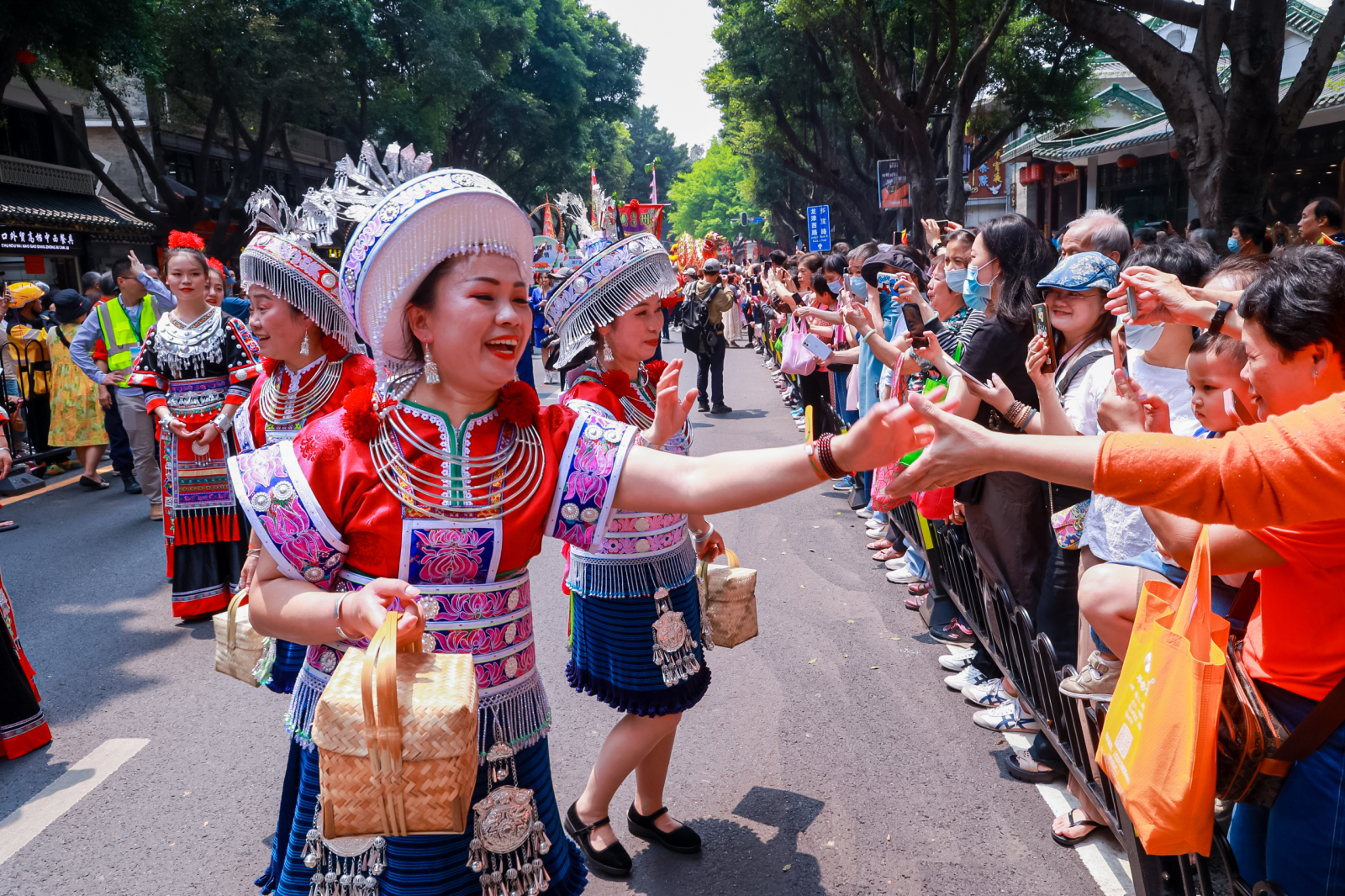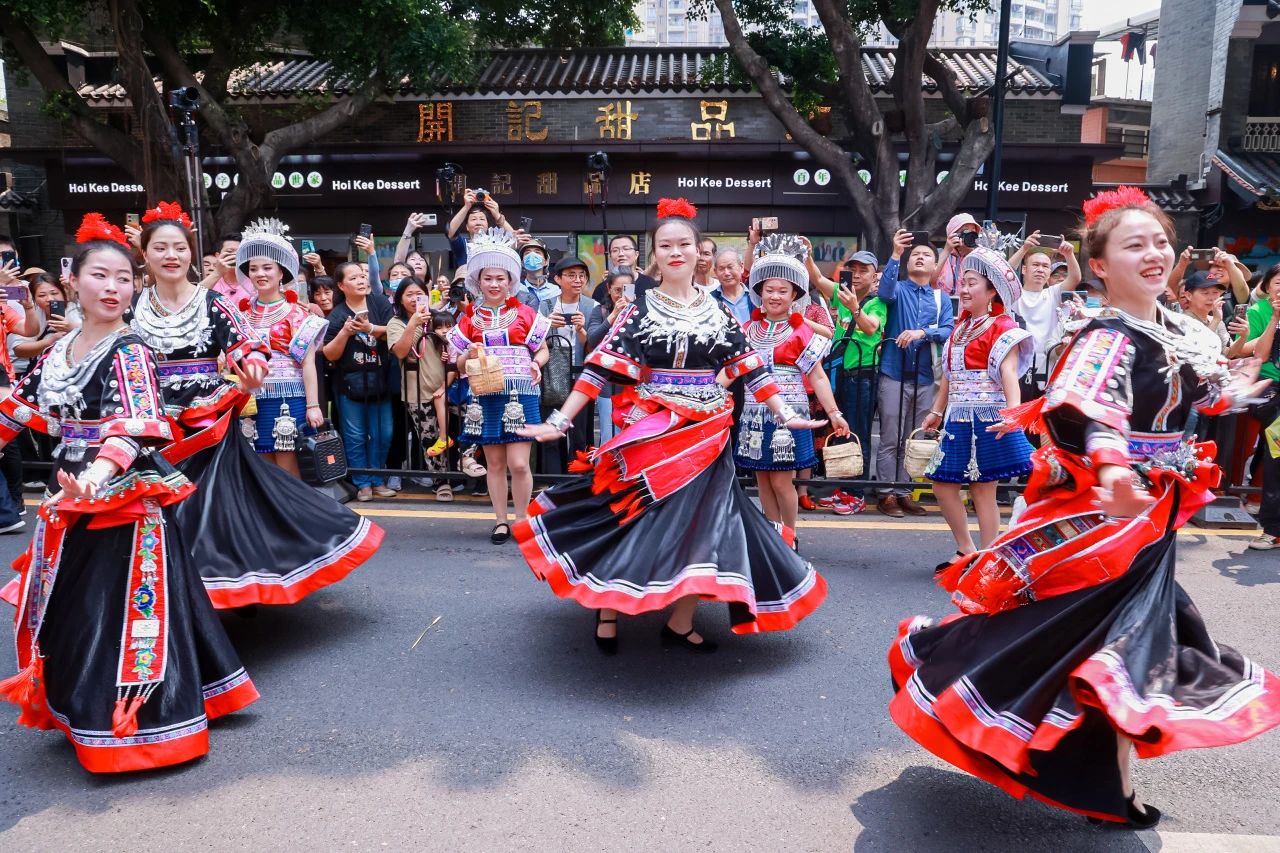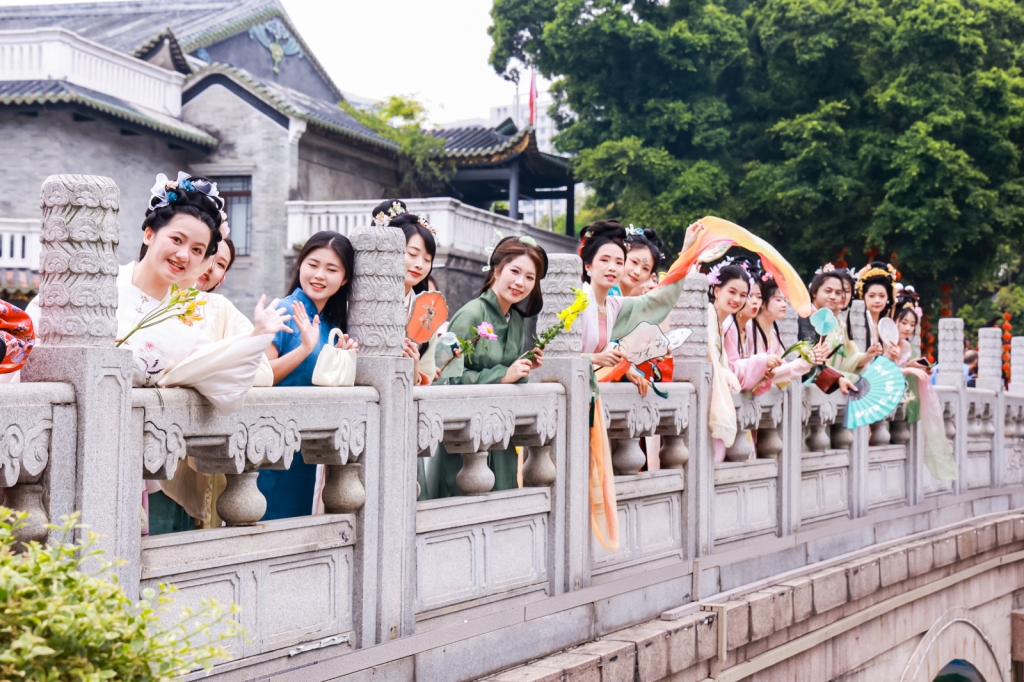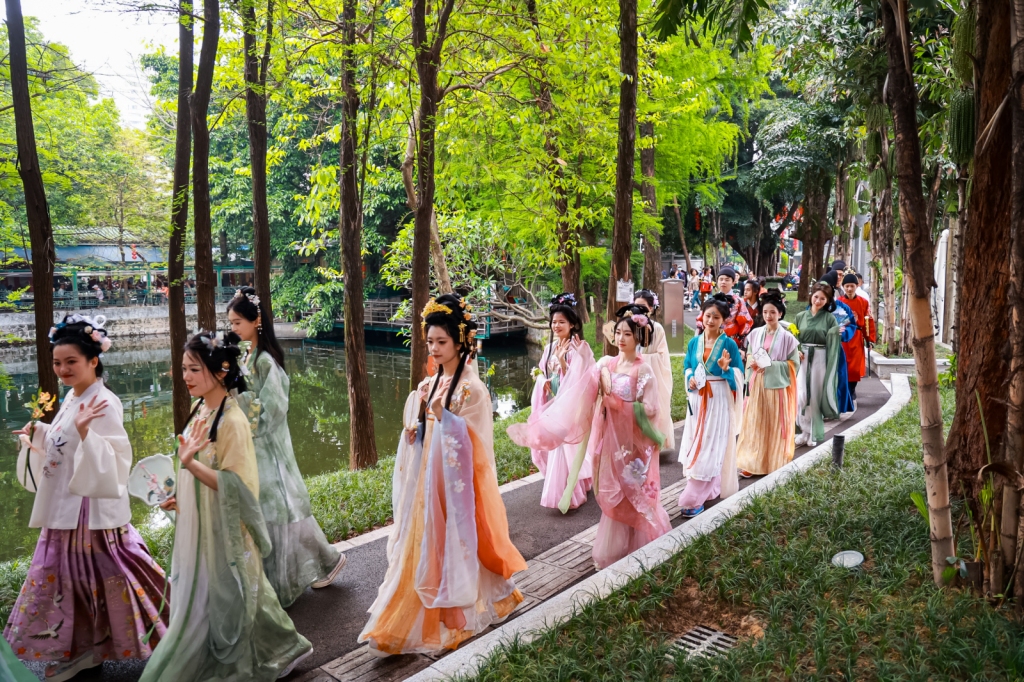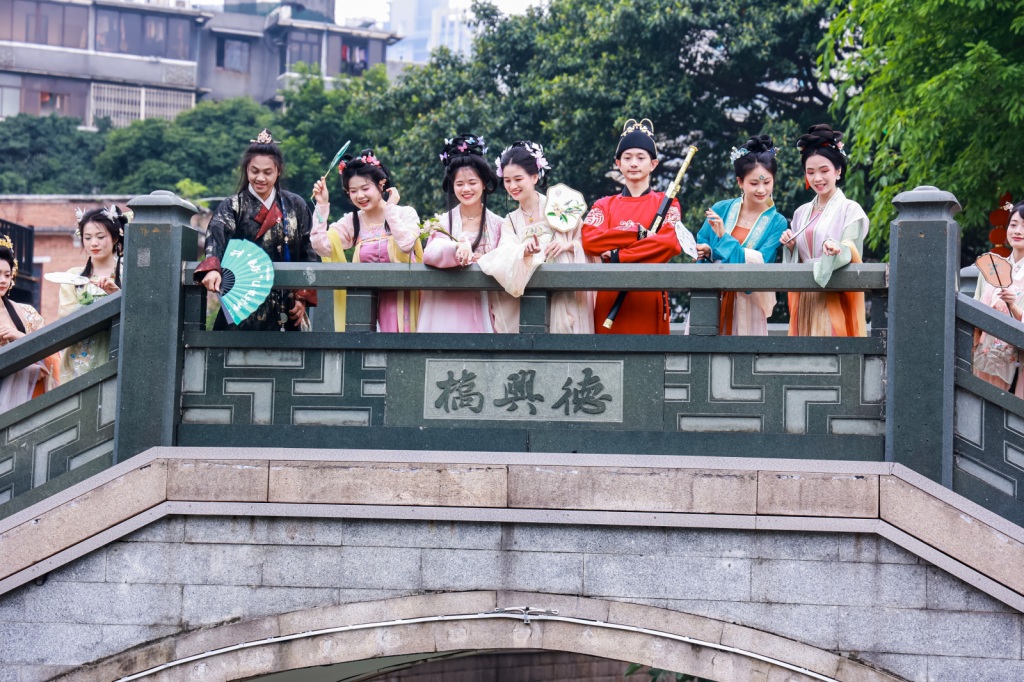Enjoy the present spring day, on the 3rd day of the 3rd lunar month in Lychee Bay. The 14th “Lychee Bay and New Xiguan” Folk Culture Event: “The 3rd Day of the 3rd Lunar Month in Lychee Bay” – Spring Returns in Shangsi Festival (also known as the Double Third Festival,), Feast of Pak Tai and Long-table Banquet Activities officially commenced at Renwei Temple, Pun Tong, Liwan District on the morning of April 11 (the 3rd day of the 3rd lunar month). This auspicious event was led by the Department of Culture and Tourism of Guangdong Province, supported by the Guangzhou Municipal Bureau of Culture, Radio, Television and Tourism and the Foshan Municipal Bureau of Culture, Radio, Television and Tourism, and hosted by the People’s Government of Liwan District, Guangzhou City, the People’s Government of Nanhai District, Foshan City and the People’s Government of Chancheng District, Foshan City.
Enjoy the finest flavors of life during the Shangsi Festival
The word “Shangsi” was first documented in the literature of the early Han Dynasty. The Shangsi Festival, changed to the 3rd day of the 3rd lunar month after the Wei and Jin Dynasties, was an important festival in ancient times to perform the ritual of “getting rid of evils by bathing in the river”. People went to the riverside to bathe together in an act known as “Fuxi” (exorcistic ablutions). This practice was adopted by future generations and has subsequently gained recognition as a festival of drinking by the water, taking an outing in the suburbs, and floating wine cups along the winding water. As the birthplace of the millennial commercial city, Xiguan has always been a bustling place where merchants come and go, and restaurants and other business premises intersect. To this day, it retains the look and feel of a Lingnan water town with interlaced rivers and fragrant flowers on the waterfront.
A parade in Lychee Bay on the Shangsi Festival is a time-honored tradition held by Guangzhou citizens to celebrate “The Double Third Festival” and the longest-lasting folk custom “city walk”. This event sees the participation of almost everyone in the community. Early in the morning of “The Double Third Festival”, dozens of dancers clad in Han Chinese traditional attire and costumes with traditional Chinese elements paraded together along Lychee Bay for sightseeing in the gardens. They also presented flowers and herbs to passers-by, showing the scene of exorcistic ablutions in ancient times. Upholding old traditions in new ways has been the impetus for organizing folk custom activities in Liwan in recent years. The constant integration of new people and cultural fashions with traditional culture has seen traditional folk custom activities morph into phenomenal urban extravaganzas.
First, the atmosphere in the city-landscape-blending leisure and cultural blocks in the Liwan Lake and Lychee Bay Scenic Area is flourishing. There are singing birds and fragrant flowers across all seasons. The flower fairs on water, Yangcheng night markets, and other types of fairs are thriving. Second, with silence in the midst of the urban noise and a perfect blend of motion and stillness, the Pun Tong ancient village has attracted men of literature and writing, injecting new vitality into the ancient village and allowing folk customs and arts to complement each other. The parade departed from Pun Tong, with several historical and cultural blocks in Liwan District connected along the route, allowing the public to appreciate the multiple customs of Xiguan, such as the architecture, food, commerce and intangible cultural heritage. Meanwhile, the overlapping between city and town and between scenery and travel presented a “big gift package” in the form of a folk custom parade.
Following the bustling launch ceremony, the highlight of this year’s “The Double Third Festival” activities, the large-scale folk culture parade, officially began. This year’s parade squares were commendable, including the Cantonese Opera team with outstanding local characteristics in Xiguan, the elegant and beautiful Miss Xiguan reappearing in Xiguan, and the Pun Tong Five Delicacies, Kirin dance, and Lingnan puppetry that represent the local cultures of Guangzhou and Liwan. The performers demonstrated their talents and skills to the public, giving them a deeper experience of Xiguan during the parade. In addition to the Chancheng martial arts team symbolizing Guangzhou and Foshan being the members of one family, teams from Huishui of Guizhou, Meijiang of Meizhou, and king singers of Guangxi joined the parade and jointly presented their unique skills to the audience in Lychee Bay.
Go on a Parade to Attend the Celebration and Enjoy All over Lychee Bay
The Pun Tong lion dance team walked at the front of the parade. Pun Tong Village, which has a history of about 900 years, retains the original Lingnan culture and boasts an everlasting folk culture such as the Feast of Pak Tai, racing dragon boats, and lion dance. There is a tradition of meeting friends with lion dances in the village. During major festivals, villagers will ring gongs and drums and perform lion dances and dragon dances for celebration.
The Cantonese Opera team is a typical representative of the Lingnan culture. The Cantonese Opera originally had 10 major roles, including Mut (old man roles), Sang (male roles), Daan (female roles), Zing (roles with painted faces), Cau (clownish figures), Ngoi (elderly male roles), Siu (young male roles), Fu (elderly female roles), Tip (young female roles) and Zaap (subordinate roles), which were reduced to six categories later, including Man Mou Sang (civilized martial man), Siu Sang (young gentleman), Jing Yan Faa Daan (principal female role), Yi Bong Faa Daan (supporting female role), Cau Sang (male clown) and Mou Sang (male warrior role). There was both the heroic Cantonese Opera Mou Sang and the gorgeous Cantonese Opera Faa Daan in the parade.
Liwan District is a core area of origin and inheritance of the Cantonese Opera and Cantonese music culture in China, as well as one of the most important birthplaces of the Cantonese Opera and Cantonese music culture at home and abroad. In recent years, Liwan District has successfully built the Ecological Protection Experimental Zone of the Cantonese Opera and Cantonese Music Culture (Liwan) in Guangdong Province and created some intellectual property of the Cantonese Opera and Cantonese music culture, such as the “Cantonese Opera Day in Guangzhou, Hong Kong and Macao”, “Cantonese Rhythm in One Voice: Cantonese Music Show” and “Cantonese Opera Carnival”.
The parade departed from the Renwei Temple, Pun Tong, which always has beautiful scenery and a pleasant climate, suitable for the growth of five vegetables, including the lotus root, water chestnut, water caltrop, water bamboo shoot and arrowhead mushroom. These vegetables are the best among the ingredients and are commonly known as “Pun Tong Five Delicacies”. The Pun Tong Five Delicacies are even carved on the stone railings beside the river at the section from Dexing Bridge to Zhishan Bridge in the Lychee Bay Waterway. The local special products of the Pun Tong Five Delicacies were specially displayed in the parade, allowing people to get a further understanding of the rural and folk customs of Pun Tong as a Lingnan water town.
The Miss Xiguan parade square was beautiful and eye-catching. As a cultural symbol of the Xiguan area, this square re-displayed their profound and immense learning. The courteous and scholarly Miss Xiguan demonstrated a new demeanor of the times in a new-style cheongsam dress, which, on the basis of the traditional Chinese culture, presented the combination of the intangible cultural heritage gambiered Canton gauze and Xiguan elements on the beautiful spring day.
The Kirin dance square came by singing songs. Folk people praise Kirin as a “blessing unicorn” and hang Kirin lanterns, perform Kirin dances, and sing Kirin songs on holidays to symbolize good luck. The Huangge Kirin dance has a long history of origin and popularity and has been popular for more than 100 years. Kirin dance has become a preferred folk art form among residents in Huangge, Guangzhou.
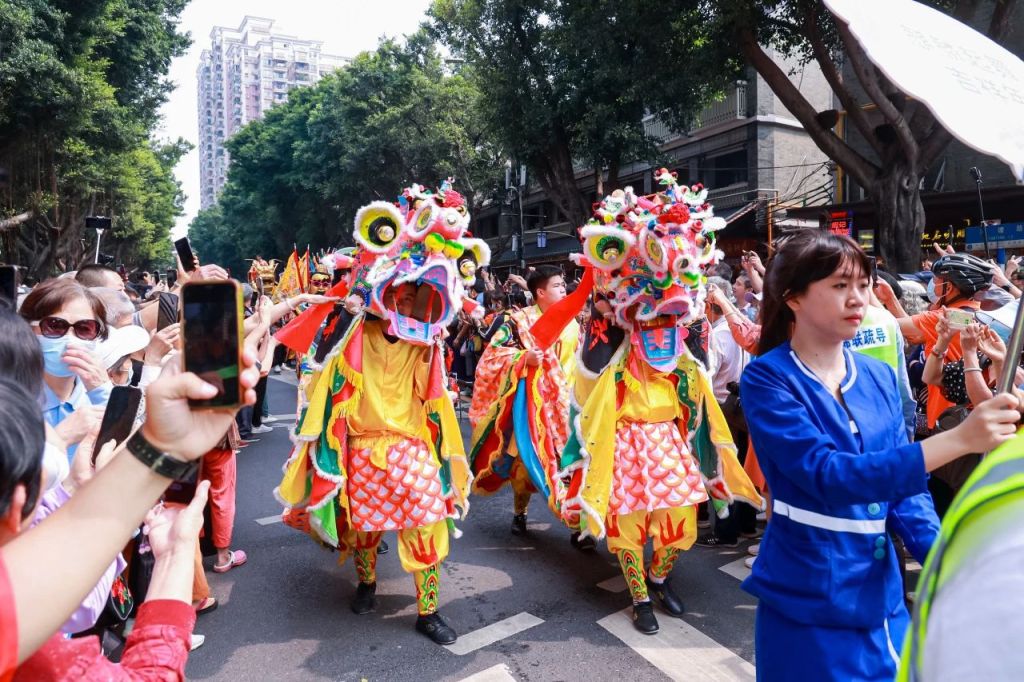
Huishui of Guizhou and Meijiang of Meizhou are brother counties of Liwan District in counterpart assistance for rural revitalization. They came to Liwan to join the grand “The Double Third Festival” event this time. The Huishui square displayed the unique Miao reed pipes, Buyei folk songs, the national-level intangible cultural heritage maple-fragrance dyeing, Buyei costumes and other artistic treasures. Meijiang, a national historical and cultural town, brought the Hakka culture to Liwan and displayed Hakka costumes such as cardigans, button-front cardigans, pipa cardigans and robes during the parade.
As an important component of Guangzhou’s “historical and cultural core”, Liwan bears a heavy cultural background and has witnessed the advent of countless cultural blocks, cultural relics and historical buildings over a history of more than 2200 years. In addition to the featured square performances, the parade also presented a Shangsi “city walk” in Lychee Bay. The participating friends can listen, observe, watch and feel the beautiful and charming water town scenery of Lychee Bay and a colorful feast of multicultural integration.
Moreover, on the launch ceremony of the event, Liwan District collaborated with Alibaba to formally release discount packages of RMB100 million for Gaode Taxi in Liwan tourism, covering a wide range of benefits such as pay to save, discounts when spending enough and other discounts. In particular, there is a 15% discount for taking a taxi to the Yong Qing Fang tourist area during “The Double Third Festival” event period (April 11-13), so that citizens and tourists can experience this folk culture feast in Liwan better and more conveniently.

As the old saying goes “Experience the Lingnan Culture from Liwan”, Liwan has already made great progress in carrying forward and inheriting traditional culture and made new achievements in activating the Lingnan culture. Adhering to the philosophy of protective inheritance and innovative development, Liwan, under the background of universal urban integration of Guangzhou and Foshan, gives full play to its geographical strengths as the core area of national central cities, the core area of the Guangzhou-Foshan Pole in the Guangdong-Hong Kong-Macao Greater Bay Area, and the core area of the Lingnan culture center, and strives to build itself into a new highland of the Lingnan culture that radiates to Guangzhou and Foshan and affects the Greater Bay Area.
🔸 [More exciting content is waiting for you] 🔸
The 14th “Lychee Bay and New Xiguan” Folk Cultural Event: “The 3rd Day of the 3rd Lunar Month in Lychee Bay” – Spring Returns in Shangsi Festival, Feast of Pak Tai and Long-table Banquet Activities continued:
🪕 Small-scale Folk Culture Parade (14:30-16:00 on April 12 and 13)
Traditional folk culture parade of the Feast of Pak Tai on the 3rd day of the 3rd lunar month.
📍 Parade route:
Renwei Temple → Pantang Road → Longjin Bridge → Lychee Bay Waterway → Zhishan Bridge → Lychee Park → Wuxiu Bridge → Lychee Bay Park East Gate → Pantang Road → Renwei Temple
🏮 Han Chinese Traditional Clothing and Lantern Show Night Market (14:00-22:00 on April 11-13)
The cultural and creative night market of Han Chinese traditional clothing and lantern show will open for three consecutive days in front of the Renwei Temple, accompanied by wonderful performances on the central stage. The night market will display the intangible cultural heritage of different places, integrate recreation, culture and sightseeing into one, and invite the public to participate. It will break the barriers of folk culture, variety entertainment and spiritual life to reconstruct an integrated cultural experience space.
🎭 Artistic Performances (April 11-13)
A variety of artistic performances will be staged on the square of the Renwei Temple and along the Lychee Bay Waterway day and night, bringing an audio-visual feast of diversified folk culture to the public. These performances include Lingnan guqin, natural music, Bayin luogu (eight-tone gong and drum), singing while playing a stringed instrument of the new Chinese style, Han and Tang tumblers, Wuyin zhangu (five-tone battle drum), dragon and lion dance, Dunhuang dance, as well as cultural exchanges and interviews with celebrities.

